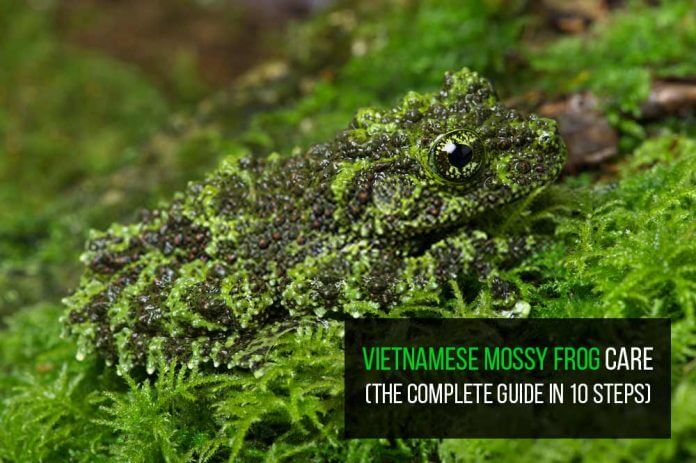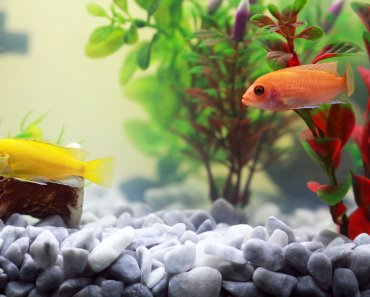Also known as bug-eyed frog and warty frog, or by its Latin name Theloderma corticale, the Vietnamese mossy frog is a sight to behold. Captivating, ugly, mesmerizing, gross – you name it. This is one of the weirdest looking frogs in the world.
Where do mossy frogs live in the wild? This expertly camouflaged frog can fit in just about anywhere. Well, anywhere that is green and a bit bobbly. Its coloration and bumpy skin give it a moss-like appearance, and makes it very well suited to the evergreen rainforests of northern Vietnam.
Recreating the wild living conditions of a Vietnamese mossy frog in a terrarium is not exactly difficult, but they must be precisely maintained. There are some basics that you have to get absolutely right, but as long as you can do that, you should be fine. For example, Vietnamese mossy frogs need a lot of water, since they are semi-aquatic animals. A few inches of water in the bottom of the tank will achieve that, and some natural cork bark for a land area. This is common practice, and does the trick.
Aside from the water supply, they also need high humidity, which is essential for maintaining healthy skin. You must also clean the tank weekly, provide a regular day-night cycle, and supply your frog with a steady supply of appropriately sized crickets, dusted with vitamins and minerals.
If you are an experienced frog-keeper, none of this should strike you as strange, or high maintenance. However, it is not advised to adopt a Vietnamese mossy frog if you are inexperienced in frog husbandry. If you do choose to start out with one, conduct ample research beforehand!
Here are the steps you will learn about in this guide:
By the time you read all this, you will know 100% whether or not the Vietnamese mossy frog is for you – and if you are for it!
Step 1: Getting the right paludarium cage and size
It is generally recommended to provide 10 gallons of space for your first frog, plus 5 for each additional frog – and these frogs are better off in small groups of 2-4. This means you might need to get hold of a 25-gallon tank!
Some of this space will have to be reserved for an aquatic section. As with most reptiles and amphibians, glass terrariums are best. While they don’t require much height, don’t squeeze your mossy frog into too small a space.
As a starting point, aim for a terrarium 18 inches tall, with a base area of 24’’ x 18’’, or 18’’ x 18’’ if you only have one or two frogs. Glass-walled enclosures are best, with transparent screen lids to allow plenty of sunlight to filter through into the frogs’ miniature world.
A long terrarium will be easier to split into two halves, or sections, dry and wet. But you can also do this with a wider terrarium. It’s up to you!
Here are some great examples of frog habitats:
Exo Terra Rainforest Habitat Kit
Zoo Med Naturalistic Terrarium (3 sizes available)
Your local pet supply store will also have plenty of options available, in various shapes and sizes.
Step 2: Setup cage lightning
Do mossy frogs require special UVB lighting?
Vietnamese mossy frogs do not require any form of special lighting. As long as they get a lot of sunlight, you don’t have to worry.
What type of lighting do they need?
A regular red or blue ‘nightlight’ is OK at night so that you can keep an eye on your frog. They are not too bright so they won’t confuse the frog’s nocturnal rhythms. Be sure that you don’t confuse these nightlights with heat lamps! The consequences could be severe.
How to set it up
It’s important to know that if you keep live plants, you may need to set up some special lighting. Otherwise, just place your frog’s terrarium in a room that receives plenty of natural lights, with a big window or glass door. Place your chosen nightlight outside the cage so you don’t run the risk of your frog knocking it over!
Step 3: Getting the right temperature for mossy frogs
What is the ideal temperature range?
Vietnamese mossy frogs like it between 65 – 75 degrees Fahrenheit. For most people, room temperature is within this range. If this is you, then you should appreciate the convenience! Many reptiles and amphibians require extra heating, so this is one way in which mossy frogs are easy to look after.
Occasional drops below 60 degrees Fahrenheit should not be a problem, since their natural habitat has fluctuations in temperature. However, anything over 80°F could be harmful, and should be avoided. These frogs live at 3,000 feet in flooded caves and on the banks of mountain streams, which are mostly cool places.
How to maintain the required temperature?
If you don’t need to adjust your room temperature to sit between 65°F and 75°F, great! If you need to increase the temperature, place a heat mat underneath the tank, under the terrestrial side. But be careful not too increase the temperature too high.
Alternatively, place a heat lamp outside the tank so that it warms one side. The key thing is to create a temperature gradient (warmer on one side than the other): this will allow your pet mossy frog to find its own sweet spot. Observe the temperature it chooses to sit in, and adjust your lamp accordingly.
Step 4: Nailing the right humidity
What is the ideal humidity?
The best humidity level for a Vietnamese mossy frog is between 60% and 90%. The good thing is this is quite a big range! So you don’t have to regulate it at a very specific or precise level.
How to measure humidity?
There are humidity meters ranging from the traditional to the high-tech. Here are a few you might want to consider:
Exo Terra Terrarium Hydrometer
Zoo Med Analog Dual Thermometer and Humidity Gauge
Zoo Med Digital Thermometer Humidity Gauge
Zilla Reptile Terrarium Thermometer & Humidity Gauge
How to maintain the right temperature?
Part of your mossy frog’s tank will be filled with water. This will release moisture into the air at a steady rate, and help maintain a high humidity level. But this won’t do it alone. So what else can you use?
Automated misting: some of the fancy ones can be connected up to your hygrometer (humidity measuring device) and set up to mist the tank whenever its humidity drops below a certain level. But non-digital misters are also useful! Here are a couple of examples:
Repti Zoo Reptile Mister Tank Humidifier and Fogger
Zoo Med Reptifogger Terrarium Humidifier
Exo Terra Cascade High Performance Pump and Filter
Manual misting: simply take a spray bottle and fill it with room temperature de-chlorinated water, and spray it generously into the tank. Repeat this two or three times per week, or when necessary.
Humidity can also be maintained by laying down a substrate that retains moisture well. Another option is to cover part of the screen lid with a sheet of plastic or glass that covers three quarters of the tank.
Here are some useful items you can opt for:
Exo Terra Mister Portable Pressure Sprayer
Choosing the best substrate for your Vietnamese mossy frog is fairly easy. There aren’t a great deal of options to choose from, so you don’t have to do much reading to narrow them down! Here are some materials you can consider:
- Aside from 2-4 inches of water covering a section of the cage, place natural cork bark around the cage. This gives them places to hide and creates a dry, land-like area for climbing, digging and basking.
- Another option is gravel, but you shouldn’t only use gravel. The bark is softer, less abrasive, and more likely to be hard-wired into the frog’s evolutionary preferences.
- You can pretty much be as elaborate as you want – within reason! You can use large and small rocks, cork bark, gravel, live plants and real moss in order to make a safe yet stimulating home for your mossy frog(s).
Step 6: Setting up water point
What type of water does the mossy frog need?
Wild Vietnamese mossy frogs thrive in water rich with tannins and organics. For the uninitiated, tannins occur in many species of coniferous trees, as well as several families of flowering plants. The tannins leach out of the plants and into the soil, which in turn drains into lakes, streams and rivers. This is how you get tannin-rich water running through the rainforests. It is brown in color, has a lower pH than neutral water, and looks a bit like tea! And it is this water that mossy frogs are accustomed to.
The organics referred to above include decay from natural vegetation. Sometimes these compounds are called lignins, but you don’t need to know about these specifically.
How to recreate tannin-rich water?
You don’t need to ship river water back from Vietnam. Start with de-chlorinated water, because this will not be harmful to the frog’s delicate skin. Then, add some Indian almond tree leaves, magnolia or oak leaves. Other leaves and roots can work too, as long as they don’t bring toxins into the water. The idea is to get some natural leaf decay.
You can also buy blackwater extract, which is frequently used by frog enthusiasts all over the world. It should be available at your local pet supply store. If not, have a look online.
Steps to set up water point
- Dechlorinate tap water with a dechlorinator like ReptiSafe or API TAP Water Conditioner.
- Add natural leaves, such as almond, magnolia or oak branches
- Or buy special compounds to emulate tannin-rich water
- Provide 2 to 4 inches of water for your frog to bathe in
Step 7: Getting the right accessories
If you plan to create a full natural biome environment, real living plants and fishes can be added to great effect. Remember, your pet’s needs come first. If you can, try to recreate something as close to its natural habitat as possible!
Here some examples of what you might include in your frog’s terrarium, in order to make it the best it can be:
- Live plants – they take a bit of maintenance, it’s true, but there’s nothing like the real thing. Live plants oxygenate the air inside the terrarium, and will boost your frog’s mood.
- Peace Lily: peace lilies have attractive roots and help create a shoreline look inside your frog’s terrarium.
- Golden Pothos: often found in reptile terrariums, golden pothos can be integrated into your substrate or planted as background. Your choice!
- Live moss – no prizes for guessing that the Vietnamese mossy frog is fond of moss! So much so, it was named after it. The issue is that moss can be tricky to keep alive in an enclosed terrarium. Placing it on a substrate that drains well helps. Pillow moss is a popular choice.
- Fish – believe it or not, certain species of fish can integrate well into a mossy frog enclosure. These fish are small, peaceful and low maintenance. Have a look online for a more substantive list, but here are a few ideas:
Step 8: Mossy frog diet: What do they eat?
Vietnamese mossy frogs are nocturnal insectivores, meaning their diet mostly consists of insects. In the wild, they eat whatever they can get a hold of. To accurately recreate this diet would be very difficult! They eat worms and a range of other invertebrates. They are not picky – as long as it’s a creepy crawly!
List of possible foods
Crickets
dust them with vitamin and mineral supplements, and these can form the lion’s share of your frog’s diet. Easy!
Get all crickets of various sizes here.
Worms
They make a lovely, fatty, protein-filled treat for basically any frog. Just don’t let them form the basis of your frog’s diet, because they might put on too much weight.
Suitable worms for mossy frog
Roaches
The thing to watch out for with roaches is the relative sizes of roach and frog. Some roaches are quite large and juvenile mossy frogs will have a hard time getting their mouths around them, and might harm their mouths on the hard exoskeleton.
To find the right sized roaches, head over to this link here.
Feeding frequency, and how to feed
Feed your frog at night. Turn out the lights and wait for 20 minutes or so, it’s not an exact science – go get ready for bed, or make yourself a brew. Then, drop in 2-3 live crickets of suitable size. If you feed every other day, then double the portions. Be careful not to let your crickets fall straight into the water and die – frogs like to hunt for their meal!
If in doubt, place the crickets into a small bowl, just large enough so that the crickets can’t jump out. Put the bowl on the land part of the terrarium, or floating on the water.
The best sized crickets for your mossy frog?
- Juveniles should be fed ⅛ inch – ¼ inch crickets
- Adults can eat full-sized crickets
If you are feeding worms, start by cutting them up into thirds, then halves. Only introduce cockroaches if you are sure your frog can handle them!
Step 9: How to handle your mossy frog
Important things to note about handling:
Frogs are not dogs. While this may seem obvious, it is important to remember that frogs don’t enjoy affection in the same way as other animals. As amphibians, they absorb water through their delicate porous skins. This means they also automatically absorb oils, salt, sunscreen, chemicals, soap, etc., all of which can be damaging to their health.
Before you pick up your frog, wash your hands thoroughly! When you put your frog back in its enclosure, wash your hands thoroughly! This will help prevent the transfer of toxins from you to the frog, and from the frog to you.
Another thing to watch out for when it comes to handling frogs is that they can be twitchy and nervous, and make sudden jerky movements. While they may be exceptional jumpers (and safe landers), they are not used to being held a meter from the ground.
A fall from this height could be fatal. So be careful not to hold your frog too high. The safest way to handle your frog is to make only slow movements, and sit down directly onto the couch, to avoid any accidents.
Handing a Vietnamese mossy frog:
Vietnamese mossy frogs are not the most sociable animals in the world – at least, not when it comes to human contact. They may like to live in pairs or small groups, but this does not mean they want your hands all over them!
Too much handling can stress out a mossy frog, which can lead to ill health. For this reason, they are mostly considered ‘display pets’. Handling them occasionally when cleaning the terrarium, or transferring them from one place to another, is fine. But you don’t need to handle them any more than that!
Just as with other reptiles and amphibians, mossy frog paludariums need regular cleaning and maintenance. But the question is: what sort of cleaning should you do, and how often should you do it?
- Don’t clean the water too much. As you already know, in order to stay fairly faithful to their natural habitat, their water area should be rich in tannins and organics. This means not purifying it too much. Do a partial water change at least once every two weeks – once a week is also OK. But totally clean water can be harmful to Vietnamese mossy frogs!
- Obviously, only use de-chlorinated water: regular tap water is harmful to frogs, because of the chlorine it contains, as well as small amounts of other toxins. To solve this problem, simply…
- Clean the substrate every other week to start off with. If it is not very dirty after two weeks, you can do it every three or four weeks instead. To clean the cork bark, or stony substrate of choice…
- Remove the substrate.
- Place it into a fine metal colander.
- Use hot water and a scrub brush to remove away any fecal matter or bits of algae and other debris.
- Rinse well and set it aside to dry off slightly.
- While the substrate is removed, look for any uneaten insects or other pieces of food left by your frog and remove them too.
- Replace the substrate. Job done!
After handling your mossy frog, wash your hands with antibacterial soap. Frogs can carry salmonella germs, so it’s better to be safe than sorry!
Final Thoughts
That’s it! Hopefully, you learned everything you needed to learn about keeping Vietnamese mossy frogs as pets. If there’s anything you think this guide is missing, let us know in the comments below.
Vietnamese mossy frogs are not the easiest frogs to look after. They require a bit more maintenance and specialized care than some other household frogs, so it is not advised for beginners to start straight off the bat with a mossy frog. That being said, if you think they are for you, best of luck on your journey!
Also let us know in the comments below any thoughts or stories you have about Vietnamese mossy frogs. Feel free to share this guide with any frog-loving friends of yours, or anyone who might just be curious about the weird and wonderful world of frog husbandry.



























